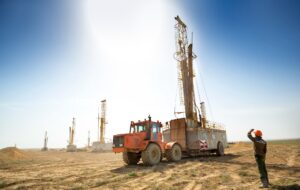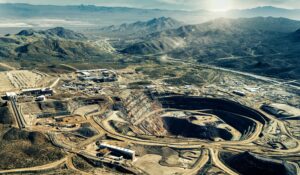After a period of sharp volatility, uranium equities are once again demonstrating their ability to catch many investors off guard: by May 2025, spot uranium hit US$73/lb — a 20% rally off the lows of March — while term prices have held steady near US$80/lb for almost a year, underscoring the strength of long-term demand from utilities.
This resurgence has been mirrored, and in some cases amplified, in uranium equities. Over the past month, some uranium stocks have rallied 19%, with year-to-date gains of 12% for producers and 15% for developers.
Yet, despite this bounce, valuations remain at “beginning-of-cycle” levels, with many equities still trading at historic discounts to long-term uranium price forecasts.
The nuclear reactor pipeline: demand is locked in
Global uranium production in 2024 covered less than 80% of reactor demand. The gap has been filled by drawdowns in inventories and spot purchases — but that buffer is shrinking.
As of Q2 2025, 439 reactors are operating globally, with another 62 under construction and 110 planned. China, India, Russia, and the Middle East are building aggressively, while the US, France, UK, Japan, and others are extending the lifespans of their existing fleets.
In May 2025, US President Trump signed four executive orders expediting reactor approvals and bolstering domestic uranium production. In particular, mandating the Nuclear Regulatory Commission (NRC) to complete rulemakings within 18 months.
Small Modular Reactors (SMRs), once theoretical, are entering commercialisation: Canada is building the first of four SMRs at the Darlington nuclear site — the first of its kind in the G7 — and the UK, the US, and Poland are also pushing forward on similar deployment.
The International Atomic Energy Agency (IAEA) projects global nuclear capacity will increase by x2.5 by 2050 under its high-case scenario.
Put simply, the uranium demand curve is rising — and this is no spike, it’s a structural trend.
Subscribe for Investment Insights. Stay Ahead.
Investment market and industry insights delivered to you in real-time.
The energy reset: nuclear comes back into focus
So far, more than 14 major financial organizations, including Goldman Sachs and Bank of America, have pledged support to triple global nuclear energy capacity by 2050, as well as more than 120 companies, headquartered in 25 countries.
The shift isn’t ideological, it’s financial and practical.
Nuclear provides baseload energy with zero emissions. Unlike wind and solar, it doesn’t depend on weather. Unlike fossil fuels, it doesn’t emit greenhouse emissions. And in a world increasingly shaped by supply chain instability and geopolitical tension, it offers something rare: reliability.
This is driving a global nuclear resurgence.
31 countries are committed to tripling nuclear capacity by 2050 — potentially tripling forecasts for long-term demand growth for uranium to fuel it.
Supply is failing to keep up
Despite the bullish outlook on demand, supply remains stuck in the past, with a growing prodution gap.
In 2024, global uranium mine production totaled approx 155 million pounds of U₃O₈, while reactor requirements reached approx 195 million pounds in 2024, leaving a 500 million pound shortfall — made up from stockpiles and secondary sources
The supply gap,currently filled by inventory drawdowns, enrichment underfeeding, and government reserves, is becoming unsustainable
Following the 2011 Fukushima Daiichi disaster, global reactor shutdowns — particularly in Japan and parts of Europe — led to a collapse in uranium demand, creating a prolonged surplus that masked structural weaknesses in mine supply. For the last 10+ years, utilities took advantage of the resulting low prices and built inventories, relying on spot market purchases and enrichment underfeeding rather than securing long-term contracts. However, those stockpiles have been steadily drawn down, underfeeding is reversing, and that window is quickly closing as utilities return to long-term contracting. The era of surviving on secondary supply is over.
- Western utility inventories are now significantly lower than they were in 2010
- Cameco’s production is reportedly “sold out” for the next 5 years
- Russian supply, once a key backstop, faces increasing restriction in the West. A US ban on Russian uranium imports begins a phased implementation from 2024 to 2028
- the restart of enrichment underfeeding to life-extensions across Western facilities is already underway, further increasing raw uranium requirements
Long lead times, low incentive pricing
Uranium mines are not like lithium brine ponds or rare earth separation facilities. They take time, capital, and regulatory alignment to develop, with the average time from discovery to production taking an estimated 13 years.
Therefore, many Tier 1 projects remain shelved or mothballed due to low incentive pricing during the 2011–2020 downcycle.
Even at US$67/lb spot (March 2025), only a subset of global undeveloped projects are economically viable under current inflation-adjusted development costs.
The consequence is a supply chain that can’t respond quickly to demand, with new pounds no longer available to be delivered on short notice.
The price response: contracts catch up
The uranium market is bifurcated between spot and term:
- Spot price: ~$71/lb (May, 2025), up from ~$30/lb in 2020
- long-term contract price: ~$80/lb (Jan-May, 2025), the highest since 2007
- total volume under long-term contracts in 2024: over 160 million lbs, nearly double the 10-year average
(Source: UxC, TradeTech)
This surge in contracting reflects a strategic shift with utilities, burned by past complacency, locking in supply ahead of potential geopolitical and market volatility.
Additionally, conversion and enrichment capacity constraints are pushing utilities to secure physical uranium earlier in the fuel cycle, further tightening spot availability.
The geopolitics of fuel supply
Security of supply is no longer just a mining buzzword. It’s policy.
For example, Russia accounts for 44% of global enrichment capacity; over 95% of US uranium requirements are imported, largely from Canada, Kazakhstan, Australia, and, until recently, Russia; and China controls the fastest-growing nuclear fleet, but is also stockpiling uranium at a strategic scale — in particular, buying up the majority of future contracts with the world’s largest uranium produce Kazakhstan.
In response, especially in the US, there has been a wave of legislative and regulatory responses. In particular, the US passed legislation banning Russian uranium imports, and allocating $3.5 billion to support domestic nuclear fuel and enrichment production; Canada wants to introduce fast-track permitting incentives for domestic uranium projects; and the European countries, such as Sweden, are looking into ending uranium mining bans.
The result: uranium from politically stable, Western-aligned jurisdictions — aka North America — is commanding a growing premium.
Early stage of the cycle: the opportunity for uranium
1. structural deficit
The demand pipeline is visible and long-term. The supply response is slow and underfunded. This is the classic set-up for a sustained commodity bull cycle.
With more than 80 designs of Small Modular Reactors (SMRs) in advanced stages of planning, and several pilot deployments scheduled in 2026–2028, this demand cycle will be accelerated.
Continued purchases by funds like Sprott Physical Uranium Trust (SPUT) reduce spot market liquidity and increase price sensitivity. We are not there yet but, if inventories fall below operational thresholds, a surge in demand from utilities could squeeze spot prices quickly.
2. energy transition alignment
Unlike oil or gas, uranium benefits from the energy transition narrative. Nuclear is now accepted by major ESG frameworks, including the EU (where Germany recently signaled it will no longer object to treating nuclear power on a par with renewable energy in EU legislation). This brings new pools of capital into the sector.
3. price support and utility discipline
With term contracting rising and the return of utility discipline, price volatility is likely to be underpinned by physical demand rather than speculative activity.
4. asymmetric investment profile
Most uranium equities are still trading below their 2007 peaks. Many are below 2011 levels. This gives investors exposure to long-duration upside in a market just beginning to re-rate.
What the market is pricing in — and what it isn’t
The spot price reflects tightening. Equity markets are partially pricing in higher uranium prices, but they are not fully accounting for:
- the long-term strategic nature of nuclear in energy grids across the West and Asia
- the fragility of current supply chains in a world of shifting alliances and trade restrictions
- the scale of capital and time needed to bring new mines online
In previous uranium cycles, the leverage in equities, particularly developers and near-term producers, was extreme. In 2004–2008, the uranium spot price went up by over 12x to approx US$140/lb.
While that cycle was driven by speculative momentum, today’s setup is grounded in structural realignment.
The Juniors, the opportunity
Tier-one producers like Cameco and Kazatomprom will benefit from higher prices. But junior miners offer the torque with exploration upside and M&A potential.
Most juniors are volatile. They rely on drilling success, permitting wins, and capital markets support. But they also offer exponential upside in a rising commodity bull market, particularly in a sector as strategically vital and politically aligned as uranium. What’s more, there are some juniors out there – at few at least – that have a sufficiently diverse pipeline of assets that provides that upside while also insulating against volatility.
The question isn’t if uranium will break out again—but who will deliver it.
And, the piece of puzzle that secures high-grade uranium in a secure jurisdiction with significant government policy momentum (the US imports over 95% of its uranium) is North America. In particular, our company spotlight in our latest uranium report:
IsoEnergy (NYSE: ISOU and TSX: ISO) stands out in the junior uranium space for its focus on near-term production potential and long-term value creation—across some of the most strategic jurisdictions in the global nuclear fuel supply chain including, Canada, the US and Australia.
The company’s US portfolio includes fully permitted, past-producing mines in the State of Utah (after its acquisition of Consolidated Uranium) that adds near-term US production assets into the company’s portfolio—giving IsoEnergy immediate leverage to rising uranium prices and US policy tailwinds. This is rare among juniors, most of whom are years from production. This also includes Coles Hill, the largest undeveloped uranium deposit in the US in the State of Virginia.
The company’s flagship Hurricane deposit, located in the Athabasca Basin, remains one of the highest-grade undeveloped uranium discoveries in the world, with an indicated mineral resource of 48.6 million pounds at 34.5% U₃O₈.
In a market that rewards jurisdictional safety, asset quality, and scalability, IsoEnergy offers rare exposure to all three.
Conclusion: don’t wait for the all-clear
This isn’t 2007. The investor base is better informed. The capital is more disciplined. And the geopolitical case for secure nuclear fuel is much stronger. We’re not just in a uranium cycle, we’re in a structural shift. But the market is significantly more volatile.
For example, the broader investment community and many institutional funds remain underweight uranium. Retail remains focused on flashier narratives like tech and AI.
This is the window where the fundamentals are strong, the valuations remain attractive, and the re-rating has just begun. By the time uranium hits $90–100/lb, many equities will already have repriced. The best opportunities come before consensus.
We believe uranium remains one of the most asymmetrical commodity opportunities in the 2020s—driven by energy security, climate policy, and a hard floor under supply. We remain focused on positioning early in jurisdictions with policy support and geological quality.
Subscribe for Investment Insights. Stay Ahead.
Investment market and industry insights delivered to you in real-time.




















